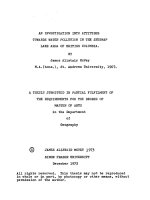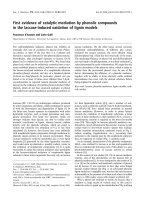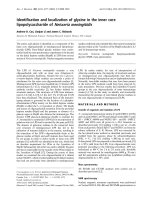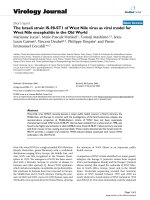PESTICIDES IN THE MODERN WORLD – EFFECTS OF PESTICIDES EXPOSURE ppt
Bạn đang xem bản rút gọn của tài liệu. Xem và tải ngay bản đầy đủ của tài liệu tại đây (15.42 MB, 388 trang )
PESTICIDES IN THE
MODERN WORLD
– EFFECTS OF
PESTICIDES EXPOSURE
Edited by Margarita Stoytcheva
Pesticides in the Modern World – Effects of Pesticides Exposure
Edited by Margarita Stoytcheva
Published by InTech
Janeza Trdine 9, 51000 Rijeka, Croatia
Copyright © 2011 InTech
All chapters are Open Access articles distributed under the Creative Commons
Non Commercial Share Alike Attribution 3.0 license, which permits to copy,
distribute, transmit, and adapt the work in any medium, so long as the original
work is properly cited. After this work has been published by InTech, authors
have the right to republish it, in whole or part, in any publication of which they
are the author, and to make other personal use of the work. Any republication,
referencing or personal use of the work must explicitly identify the original source.
Statements and opinions expressed in the chapters are these of the individual contributors
and not necessarily those of the editors or publisher. No responsibility is accepted
for the accuracy of information contained in the published articles. The publisher
assumes no responsibility for any damage or injury to persons or property arising out
of the use of any materials, instructions, methods or ideas contained in the book.
Publishing Process Manager Sandra Bakic
Technical Editor Teodora Smiljanic
Cover Designer Jan Hyrat
Image Copyright 2010. Used under license from Shutterstock.com
First published September, 2011
Printed in Croatia
A free online edition of this book is available at www.intechopen.com
Additional hard copies can be obtained from
Pesticides in the Modern World – Effects of Pesticides Exposure,
Edited by Margarita Stoytcheva
p. cm.
ISBN 978-953-307-454-2
free online editions of InTech
Books and Journals can be found at
www.intechopen.com
Contents
Preface IX
Part 1 Pesticides Exposure 1
Chapter 1 Chronic Exposure to Pesticides- Neurological,
Neurobehavioral and Molecular Targets of Neurotoxicity 3
Binukumar B.K and Kiran Dip Gill
Chapter 2 Dermal Exposure to Sub-Toxic
Amount of Chlorpyrifos - Is It Neurotoxic? 21
Nilesh Kumar Mitra
Chapter 3 Effect on Workers’ Health Owing to
Pesticides Exposure: Endocrine Target 33
Lidia Caporossi and Bruno Papaleo
Chapter 4 Health Problem Caused by Long-Term
Organophosphorus Pesticides Exposure - Study in China 59
Zhi-Jun Zhou
Chapter 5 Pesticide Exposure of Farmworkers’ Children 79
Paloma I. Beamer
Chapter 6 Migrant Farm Workers Exposed to
Pesticides in Sinaloa, Mexico 101
Anthon Alvarez A. and Alba D. Campaña S.
Chapter 7 Work Practices, Exposure Assessment and Geographical
Analysis of Pesticide Applicators in Argentina 115
María Josefina Lantieri, Mariana Butinof, Ricardo Fernández,
María Inés Stimolo, Marcelo Blanco and María del Pilar Díaz
Chapter 8 Separation of Chiral Pyrethroid Pesticides
and Application in Pharmacokinetics
Research and Human Exposure Assessment 139
Yongning Wu, Hong Miao and Sai Fan
VI Contents
Chapter 9 Biomonitoring of Contemporary Pesticides:
Ethylenethiourea in Occupational Settings 167
M. Angela Montesano and Richard Wang
Chapter 10 Pesticide Residues in the Organically Produced Food 181
Ewa Rembiałkowska and Maciej Badowski
Part 2 Pesticides and Human Health 203
Chapter 11 Pesticides and Human Health 205
Khaled A. Osman
Chapter 12 Pesticides and Human Health 231
Alewu B. and Nosiri C.
Chapter 13 A Forensic View of Pesticide Poisonings in Brazil 251
Bruno Sabino, Hannah Rozenbaum and Adriana Oliveira
Chapter 14 Characteristics and Trends with Respect to
Unintentional Pesticide Poisoning Mortality
and Hospitalization in Taiwan, 1999-2008 279
Wu-Chien Chien,
Ching-Huang Lai, Jouni J.K. Jaakkola,
Lu Pai, Senyeong Kao, Jin-Ding Lin and Yu-Chen Hung
Chapter 15 Pathology of Endosulfan 289
Ozlem Ozmen
Chapter 16 Pesticides and Parkinson’s Disease 307
Arthur G. Fitzmaurice and Jeff M. Bronstein
Chapter 17 Dithiocarbamate Toxicity - An Appraisal 323
Narayan C. Rath, Komal S. Rasaputra,
Rohana Liyanage, Gerry R. Huff and William E. Huff
Chapter 18 Progress in Antidotes
(Acetylcholinesterase Reactivators)
Against Organophosphorus Pesticides 341
Kamil Musilek, Ondrej Holas, Anna Horova, Miroslav Pohanka,
Jana Zdarova-Karasova, Daniel Jun and Kamil Kuca
Chapter 19 Laboratory Tests with Androgenic and
Anti-Androgenic Pesticides – Comparative
Studies on Endocrine Modulation in the
Reproductive System of Invertebrates and Vertebrates 359
Watermann, B.T., Gnass, K., Kolodzey, H. and Thomsen, A.E.
Preface
The introduction of the synthetic organochlorine, organophosphate, carbamate and
pyrethroid pesticides by1950's marked the beginning of the modern pesticides era and
a new stage in the agriculture development. Evolved from the chemicals designed
originally as warfare agents, the synthetic pesticides demonstrated a high effectiveness
in preventing, destroying or controlling any pest. Therefore, their application in the
agriculture practices made it possible enhancing crops and livestock’s yields and
obtaining higher-quality products, to satisfy the food demand of the continuously
rising world’s population. Nevertheless, the increase of the pesticide use estimated to
2.5 million tons annually worldwide since 1950., created a number of public and
environment concerns.
This book, organized in two sections, comments on the major aspects of the pesticides
risk, integrating pesticides exposure and pesticides health effects.
Chapter 1 covers the background information and the epidemiological evidence on the
long-term pesticides exposure, commenting on the genetic susceptibility to pesticide
toxicity, on the developmental toxicity and neurotoxicity, and on the neurobehavioral
impairments provoked by pesticides exposure.
Chapter 2 explains how dermal exposure to sub-toxic amount of chlorpyrifos is
connected to neurotoxicity. Most occupational exposures are dermal. The authors
conclude that high dosage of chlorpyrifos can result in significant neurotoxicity, while
low dosage produces a reduced level of neurotoxicity.
Chapter 3 inventories the typical sources and routes of occupational pesticides
exposure, focusing on the ability of pesticides to interfere with the endocrine system
and to cause adverse effects, and discussing the approaches to be applied for
prevention and protection.
The effects of long-term low-level exposure to organophosphorus pesticides in both
general and occupational population in China, exposure assessment, and studies on
the mechanism of the organophosphorus pesticides action are considered in Chapter 4.
Chapter 5 reviews the exposure pathways and the neurodevelopment injuries in
children of farm workers in U. S., associated with chronic pesticides exposure.
X Preface
Effective interventions conducting to increasing of the farm workers self-protective
behaviours and perception of control are discussed, too.
The alteration of the erythrocyte cholinesterase activity, and the affection of the
process of hemostasis in migrants workers exposed to the action of organophosphorus
pesticides in the Mexican state Sinaloa is the objective of the investigations, presented
in Chapter 6.
Chapter 7 addresses the work practices of the pesticide applicators in Cordoba
province, Argentina. Exposure indexes and scales proposed in this work are helpful
tools for the assessment of occupational risks related to pesticide exposure.
In Chapter 8 are discussed the various methods of chiral separation of synthetic
pyrethroids. It has been demonstrated that chiral isomers exhibit different biological
activities and toxicities, and thereby the residues and metabolisms in the environment
and biological organisms also vary.
Chapter 9 illustrates the importance of biological monitoring in the assessment of
human occupational exposure to pesticides, facing in particular the exposure to
ethylenebisdithiocarbamates. It comments on the main factors in biomonitoring such
as sampling methods, analytical determination, and interpretation of the results.
Chapter 10 presents numerous evidences confirming that the presence of pesticide
residues in organic food is lower than in conventional products. Thus, the risks
associated to pesticides exposure are reduced.
The main topics discussed in Chapters 11 and 12 include hazard identification,
exposure assessment, dose-response assessment and risk characterization associated
with pesticides exposure and human health.
The forensic aspects of pesticides poisoning in Brazil, and the forensic analytical
chemistry of pesticides are commented in Chapter 13.
Chapter 14 is intended to examine the characteristics and trends of unintentional
pesticide poisoning mortality and hospitalization in Taiwan. Taking into consideration
that currently no authority in Taiwan is in charge of pesticide poison surveillance, the
present work is the most complete nationwide population-based study conducted to
assess the risk of pesticide poisoning.
Chapters 15 and 16 provide pathological findings on endosulfan toxicity to human and
animals, and epidemiologic evidences strengthening the hypothesis that exposure to
pesticides could increase the risk of developing Parkinson’s disease.
The objective of Chapter 17 is to review and to highlight some of the recent findings on
the effects of dialkyl dithhiocarbamates and ethylene-bis-dithiocarbamates pointing
out on studies of the avian system, which has not been a focus of earlier literature. It is
Preface XI
demonstrated that cells exposed to dithiocarbamates experience increased oxidative
stress and metabolic disregulations leading to tissue damage and apoptosis.
Chapter 18 provides information on the potency of the commercially available
acetylcholinesterase reactivators (pralidoxime, methoxime, trimedoxime, obidoxime,
asoxime, etc.) developed against organophosphorus pesticides intoxication, and on the
reactivation capability of some promising novel reactivators produced in the last
decade, such as the mono-oximes from the K-compound series.
Chapter 19 reports investigations on the effects of several pesticides on the
reproductive system of echinoderms, crustaceans, molluscs, fish, one amphibian and
one mammalian species. The concentrations, selected in the range of the
environmental concentrations, are discussed with respect to ecotoxicological impacts.
The book is a compilation of works, addressing the various aspects of the pesticides
exposure and the related health effects. It offers a large amount of practical
information to the professionals interested in pesticides issues. The commitment of
each of the contributing authors with the present project is gratefully acknowledged.
Margarita Stoytcheva
Mexicali, Baja California
Mexico
Part 1
Pesticides Exposure
1
Chronic Exposure to Pesticides- Neurological,
Neurobehavioral and Molecular
Targets of Neurotoxicity
Binukumar B.K and Kiran Dip Gill
Department of Biochemistry, Postgraduate Institute of
Medical Education and Research, Chandigarh,
India
1. Introduction
There is an increasing concern regarding the widespread use of pesticides and their
potential impacts on public health. Pesticides differ from other chemical substances because
they are toxic chemicals deliberately spread into the environment with the aim of
controlling undesired living species. Since their toxicity may not be completely specific for
the target organisms, their use may pose a risk to human health. Pesticide poisoning
remains a serious public health problem worldwide. More than 5 billion pounds of
pesticides are used annually worldwide, with about 25% being used in the United States (US
Environmental Protection Agency 2001, 2002). Pesticide exposure occurs during their
application, via their drainage into water supplies, and through the consumption of food.
According to the World Health Organization’s estimate, 3 million cases of pesticide
poisoning occur every year, resulting in more than 250,000 deaths. This number also
accounts for a substantial fraction of the almost 900,000 people worldwide who die by
suicide every year. Organo-phosphorus pesticides (OPs) are currently the most commonly
utilized pesticides in the world, consisting of nearly 40 different chemical members
registered by the US-EPA (www.epa.gov). About 73 million pounds of OP pesticides were
used in the United States above in 2001 (70% of all insecticides; Kiely et al.,2004).
Pesticide poisonings are relatively common in countries such as Sri Lanka, Venezuela,
Indonesia, South Africa, and Brazil. Among numerous pesticides that can result in death,
organophosphate insecticides are the most common culprit agents because of their high
toxicity. In developing countries, in which the use of OP compounds is particularly
widespread because the hot climatic conditions, the number of deaths may be high. There is
an increasing concern regarding the widespread use of pesticides and their potential
impacts on public health. In the United States, a mixture of pesticide residues are detected in
blood and/or urine of nearly all persons sampled (Barr et al., 2005). During the 1990s some
2.5–5.0 million agricultural workers were exposed to OPs, which are used as insecticides
around the world (Abou-Donia, 2003; Das et al., 2001; Farahat et al., 2010; London et al.,
1997). Although OPs are increasingly restricted for use in the US (EPA, 2002), many of the
pesticides that are no longer available in the US and other developed countries are still
being produced and used in agricultural or urban applications in developing countries.
Pesticides in the Modern World – Effects of Pesticides Exposure
4
The mechanism of action of pesticides frequently involves a neurotoxic effect:
organophosphorous compounds act through the inhibition of central nervous system
cholinesterase (Jeyaratnam and Maroni, 1994; Machemer and Pickel, 1994); pyrethroids affect
the sodium channels of the nerve membrane, keeping them open for more than the few
milliseconds needed for the generation of the action potential (He, 1994); organochlorinated
compounds in general act as central nervous system stimulants, but the mechanism of action
varies for the different active ingredients (Tordoir and Van Sittert, 1994); morpholine
derivatives alter the balance between excitatory and inhibitory threshold in neurons, impairing
the function of the nervous system (Barbieri and Ferioli, 1994), while formamidines have an
agonistic action on the alpha-2 catecholamine receptor (Xue and Loosly,1994).
Organophosphate (OP) pesticides can produce several distinct neurotoxic effects depending
on the dose, frequency of exposure, type of OP, and host of other factors that influence
susceptibility and sensitivity. These effects include acute cholinergic toxicity, a delayed
ataxia known as organophosphorus ester-induced delayed neurotoxicity (OPIDN), chronic
neurotoxicity and developmental neurotoxicity. Acute cholinergic syndrome, due to the
inhibition of ace-tylcholinesterase activity, which occurs within minutes or hours following
exposure, usually subsides within days or weeks, and plasma or erythocytic
acetylcholinesterase activity are used for monitoring acute exposure to OP (Lessenger and
Reese, 1999); Acute OP pesticide exposure can involve wide range of both central and
peripheral neurologic symptoms. Increased neurologic symptom prevalence may provide
early evidence of neurologic dysfunctions, before clinically measurable signs are evident.
Rastogi et al (2010) analyzed the cross-sectional data on neurologic signs and symptoms
from 225 rural children, both males (n = 132) and females (n = 93) who were occupationally
and paraoccupationally exposed to methyl OPs (dichlorvos, fenthion, malathion, methyl
parathion) and ethyl OPs (chlorpyrifos, diazinon, ethyl parathion) as they belonged to
agricultural families handling, mixing, and spraying the OP pesticides. Among all the
neurologic self-reported symptoms, headache, watering in eyes, and burning sensation in
eye/face were the most important clinical manifestations attributed to OP pesticide
exposure. These symptoms could probably be the consequence of chronic effects of most
pesticides on the central nervous system. The high frequency of neurologic symptoms
observed in the study may be due to parasympathetic hyperactivity due to the accumulated
ACh resulting from AChE inhibition (Rastogi, 2010).
Intermediate syndrome, which usually starts 24 to 96 hours after the acute syndrome and is
characterized by respiratory paresis, weakness, depressed tendon reflexes, and transient
extrapyramidal symptoms, without response to treatment with the cholinergic receptor
antagonist atropine (Bhatt et al., 1999; Mileson et al., 1998; Senanayake and Johnson, 1982;
Shahar and Andraws, 2001); Organophosphate-induced delayed neuropathy, which is a
symmetric distal neuropathy, usually occurring weeks following an acute exposure
probably related to the inhibition of the enzyme neuropathy-target esterase present in the
nervous system (Aiuto et al., 1993).
Long-term exposure to relatively low levels of OP agents occurs in a variety of
environments. Pesticides are often applied in a combination with several classes of
compounds featuring synergistic interactions. One of the neurological functions for which
an adverse effect of neurotoxic pesticides has been repeatedly hypothesized is behaviour.
Behaviour is the product of various sensory, motor and associated functions of the nervous
system, and the hypothesis is that neurotoxic substances can adversely affect one or more of
these functions, disrupt learning and memory processes, or cause detrimental behavioural
Chronic Exposure to Pesticides - Neurological,
Neurobehavioral and Molecular Targets of Neurotoxicity
5
effects (IPCS/WHO, 2001). Since behaviour is a very complex system, made of several
different functions and biochemical activities, it can be studied only based on a very
complex approach, in which different tests are performed, addressed at a large spectrum of
functions, in some cases with different approaches for different population subgroups
(Anger et al., 2000; Cassitto et al., 1990; Fiedler et al., 1996; Krasnegor et al., 1995; Wetherell,
1996), and conclusion can be drawn only from an integrated evaluation of the available data.
Because of this complexity, not surprisingly, different approaches have been chosen by
different researchers, making comparisons between different studies very difficult.
However, neurobehavioral toxicity is a very important issue for prevention, because some of
the compounds thought to be involved are largely used in agriculture, and large sections of
the human population are occupationally and/or environmentally exposed, including
possible vulnerable subgroups such as children or pregnant women. (Colosio et al, 2009).
An increasing number of papers have been and are being published on neurobehavioral
effects of pesticides. However, besides what is well established (e.g. acute effects; OP
induced delayed polyneuropathy; intermediate syndrome) (Jayawardane et al., 2009; Lotti,
2001; Lotti and Moretto, 2005), several uncertainties still remain on the real risks for workers
and consumers of developing neurobehavioral changes after long-term exposures to low
doses of neurotoxic pesticides (Colosio et al., 2003; Moser, 2007). Experimental data on
neurotoxicological outcomes in animals are abundant, but relatively few are those studies
dealing with long-term exposures (for a review see Moser, 2007). In fact, most reports in the
literature deal with repeated exposures to pesticides, mainly OPs, as short as five days and
rarely longer than three months. In addition, an even lower number of studies assessed
neurobehavioral performance days or weeks after end of exposure.
In southern Brazil, agricultural workers involved in tobacco plantation use a combination of
OP (chlorpyrifos and acephate), herbicides (glyphosate and clomazone), plant growth
regulators (flumetralin), fungicides (iprodione), and insecticides (imidacloprid). Exposure to
OP is known to induce clinical syndromes and biochemical alterations in humans. Besides
acute cholinergic symptoms, which are related to the inhibition of acetylcholinesterase
activity, acute or chronic OP exposure can also induce delayed toxic and behavioral effects
not clearly related to the inhibition of esterases (Brown and Brix, 1998; Jamal, 1997; Mileson
et al., 1998; Peter and Cherian, 2000; Sudakin et al., 2000). Most of the actions of OP on the
nervous system seem to be related to organophosphorylation of protein targets, as
acetylcholinesterase and neuropathy target esterase, or directly to binding of OP to nicotinic
receptors (Mileson et al., 1998).
Chronic organophosphate-induced neuropsychiatric disorders (COPIND) are a less well-
characterized syndrome in chronic OP poisoning. COPIND may be caused by chronic low-
level exposure to OP, without cholinergic symptoms (Ray and Richards, 2001). The
underlying mechanisms are not established, but are not dependent on inhibition of esterases
(Levin et al., 1976) The most common clinical symptoms include impairment in memory,
concentration, and learning; anxiety, depression, psychotic symptoms, chronic fatigue,
peripheral neuropathy, autonomic dysfunction and extrapyramidal symptoms such as
dystonia, resting tremor, bradikynesia, postural instability and rigidity of face muscles; and
nonresponsiveness to levodopa treatment. Regarding psychiatric symptoms,
neurobehavioral effects of low-level pesticide exposure have not been extensively studied
with standardized, quantitative neuropsychologic batteries.
OPs do not accumulate in living organisms and the acute signs and symptoms disappear as
the AChE activity returns to normal level. Therefore, they are regarded as relatively safe.
Pesticides in the Modern World – Effects of Pesticides Exposure
6
However, as some literature data suggest, after either acute or prolonged exposure to OPs
subtle neurobehavioral impairments may persist long after normalization of AChE activity.
The possibility that OPs exposure may induce such long-term effects is nowadays a problem
of great concern for the regulatory agencies. Rodnitzky et al, (1975) and Durham et al,
(1965) in their cross-sectional epidemiologic studies using neurobehavioral tests have
suggested that subtle behavioural impairments among pest control workers, farmers, and
manufacturing workers are related to low level pesticide exposure or are persistent effects of
severe acute pesticide poisoning (Metcalf and Holmes, 1969; Burkhart et al, 1978; Korsak
and Sato, 1977; Levin et al, 1976; Xintaras et al, 1978; Savage et al, 1983, reviewed by;
Johnson and Anger, 1983). There are also numerous case reports and case registries
indicating that 4-9% of individuals with acute organophosphate poisoning experience
delayed or persistent neuropsychiatric effects, including depression, weakness, nervousness,
irritability, fatigue, insomnia, forget fulness, confusion, and schizoid and depressive
reactions (Gershon and Shaw, 1961). Behavioural impairments due to pesticide exposure
have also been implicated in serious accidents among agricultural workers (Redhead, 1968;
Wood et al, 1971; Smith et al, 1968).
Amr et al. (1997) found that, compared to controls, subjects heavily exposed to pesticides (40
h/week, 9 months/year) had a signifi cant increase in the frequency of psychiatric disorders,
especially depressive neurosis and dysthymic disorder (DSM-III-R). These results left
unresolved issue of reversibility of psychiatric symptoms after a pesticide-free period and
the occurrence of syndrome in subjects not so heavily exposed to OP compounds. Another
confounding factor in these studies has been the exposures to several types of pesticides
which has been shown to reproduce features of Parkinson’s disease (Binukumar et al, 2010).
Some of the factors which have been shown to influence the feasibility of an
epidemiologic appraisal of CNS abnormalities among pesticide workers depend upon: 1)
the extent to which exposure can be quantified; 2) the multiplicity of chemical
exposures; 3) the sensitivity and specificity of the neurobehavioral test; and 4) the time
taken to conduct the test. Stephens, et al (1995) studied the relationship between chronic
(nonreversing) neuropsychological effects and acute exposure effects and investigated 77
organophosphate-exposed male sheep-dippers. Acute exposure effects were assessed
prospectively using a purpose-constructed symptoms questionnaire administered pre-, and
24 h post exposure. Urine was analysed for dialkylphosphate levels to confirm recent
exposure. Chronic effects were assessed in a cross-sectional neuropsychological study in the
absence of recent exposure using computerized neuropsychological tests, the General
Health Questionnaire, and the subjective Memory Questionnaire. Simple correlation and
multiple linear regression analyses, were used to assess relationships between the changes
in total symptoms reporting from baseline to 24 h after exposure and chronic effect
outcomes. There was no evidence of any association between reported symptom levels and
chronic neuropsychological effects. This suggests that chronic effects of OP exposure appear
to occur independently of symptoms that might immediately follow acute OP exposure.
This has implications for exposure control: individuals may experience chronic effects
without the benefit of earlier warning signs of toxic effects during acute exposures.
Military personnel returning from the Gulf War (GW) have reported symptoms that have
not only diagnosis using known disease entities but also do not appear to occur in a
predictable constellation that can be classified as a single syndrome (Persian Gulf Veterans
Coordinating Board, 1995; Institute of Medicine, 1996; Iowa Persian Gulf Study Group, 1997;
Proctor et al., 1998; Wolfe et al., 1998). However, prominent among complaints reported by a
Chronic Exposure to Pesticides - Neurological,
Neurobehavioral and Molecular Targets of Neurotoxicity
7
high percentage of several samples of GW veterans are symptoms that suggest dysfunction
in the central nervous system (CNS). These include memory loss, concentration problems,
headaches, and fatigue. Freya Kame et al (2005) analyzed cross-sectional data from 18,782
white male licensed private pesticide applicators enrolled in the Agricultural Health Study
in 1993–1997. Applicators provided information on lifetime pesticide use and 23 neurologic
symptoms typically associated with pesticide intoxication. Among chemical classes of
insecticides, associations were strongest for organophosphates and organochlorines.
Associations with cumulative exposure persisted after excluding individuals who had a
history of pesticide poisoning or had experienced an event involving high personal pesticide
exposure. These results suggest that self-reported neurologic symptoms are associated with
cumulative exposure to moderate levels of fumigants and organophosphate and
organochlorine insecticides, regardless of recent exposure or history of poisoning.
2. Behavioural studies in animals
Chronic exposure of rats to one tenth of the LC50 of sarin for 30 days induced a decrease in
M1 receptors in the olfactory tubercle, changes in blood and brain ChE activities and the
expression of cytokines mRNA levels (Henderson et al., 2002). Guinea pigs receiving 0.3, 0.4
or 0.5×LD50 of repeated sarin injections exhibited disrupted sleep pattern in the EEG (Shih
et al., 2006) and a decrease in red blood cell AChE to a low level of baseline. Obvious signs
of cholinergic toxicity were observed only in animals receiving sarin. Experiments involving
the application of multiple low-doses of soman induced alterations in long-term
potentiation (Armstrong et al., 1997). We also reported dichlorvos administration caused a
marked decrease in both the ambulatory and stereotypic components of spontaneous
locomotor activity of rats. The muscle strength and coordination of the dichlorvos-treated
animals was also significantly impaired. Besides, a marked deterioration in the memory
function assessed in terms of the conditioned avoidance response was discernible at the end
of the treatment schedule in the experimental animals (Sarin and Gill KD, 1998). In a series
of experiments Gralewicz and Soćko (1997) have demonstrated that exposures to 2-chloro-1-
(2,4-dichlorophenyl) vinyl diethyl phosphate (CVP) in rabbit resulted in a similar inhibition
of blood AChE activity but the effect of the second exposure on body temperature and
hippocampal EEG was smaller and less consistent than that of the first one. This would
indicate that some permanent changes within the CNS may occur even after a single
exposure to CVP. They also studied the CVP exposure in rat. One injection/day for ten days
at a symptomatic (3.0 mg/kg) dose inhibiting blood and brain AChE activity by about 80%,
the tolerance to CVP, assessed from the spontaneous locomotor behaviour, developed
within four to five days. However, single exposure to CVP at a symptomatic (3.0 mg/kg) or
subsymptomatic (1.0 mg/kg, less than 50% AChE inhibition) dose, or repeated exposure
(one injection/day, for ten days) at subsymptomatic doses (1.0 mg/kg or 0.5 mg/kg)
resulted in subtle changes in complex behaviours detectable after AChE activity in blood
and in the brain had returned to the normal level. The changes neophobia in the open field,
an increased and more persistent emotional response to a stressful stimulus, and increased
EEG arousal response to an external pain signalling stimulus suggest an increased reactivity
of the system or systems responsible for the induction of fear. Direct intrahypothalamic
injections of CVP, unlike those of oxotremorine, a direct stimulant of cholinergic muscarinic
receptors, did not induce overt changes in the animal (rabbit) behaviour and EEG. This
would indicate that the changes in the CNS functions after CVP exposure may be the
Pesticides in the Modern World – Effects of Pesticides Exposure
8
consequence of increased cholinergic activity due to AChE inhibition rather than to a direct
stimulation of cholinergic muscarinic receptors by CVP. The above findings provide
experimental evidence that health effects of exposure to CVP, may persist after recovery of
AChE activity in blood and in the brain. (Gralewicz and Soćko ,1997).
Alvin et al (2007) have demonstrated that rats when injected with CPF subcutaneously (dose
range, 2.5-18.0 mg/kg) every other day over the course of 30 days, and then given a two
week, CPF-free washout period, dose dependent decrements in a water maze hidden
platform task and a prepulse inhibition procedure were observed during the washout
period, without significant effects on open field activity, rotarod performance, grip strength,
or a spontaneous novel object recognition task. After washout, levels of CPF and its
metabolite 3,5,6-trichloro-2-pyridinol (TCP) were minimal in plasma and brain, however,
cholinesterase inhibition was still detectible. Further, the 18.0 mg/kg dose of CPF was
associated with (brain region-dependent) decreases in nerve growth factor receptors and
cholinergic proteins including the vesicular acetylcholine transporter, the high affinity
choline transporter, and the nicotinic acetylcholine receptor. These deficits were
accompanied by decrease in anterograde and retrograde axonal transport measured in
sciatic nerves exvivo. Thus, low-level (intermittent) exposure to CPF has persistent effects
on neurotrophin receptors and cholinergic proteins, possibly through inhibition of fast
axonal transport. Such neurochemical changes may lead to deficits in information
processing and cognitive function. We report that (Binkumar et al, 2010), chronic OP
(dichlorvos) exposure (2.50 mg/kg b.wt.s.c/daily for 12 weeks) can also caused nigrostriatal
dopaminergic degeneration. The degenerative changes were accompanied by a loss of 60-
80% of the nigral dopamine neurons and 60-70% reduction in striatal dopamine and tyrosine
hydroxylase levels. Dichlorvos exposed animals also showed α-synuclein and ubiquitin
positive inclusions along with swollen, dystrophic neurites and mitochondrial abnormalities
like decreased complex I&IV activities, increased mitochondrial size, axonal degeneration
and presence of electron dense perinuclear cytoplasmic inclusions in the substantia nigra of
rats. These animals also showed evidence of oxidative stress, including increased
mitochondrial ROS levels, decreased MnSOD activity and increased lipid peroxidation.
Measurable impairments in neurobehavioral indices were also observed. Notable
exacerbations in motor impairments, open field and catalepsy were also evident in
dichlorvos exposed animals. All these findings taken together indicate that chronic
dichlorvos (OP) exposure may cause nigrostaital neurodegenaration and significant
behavioral impairments. Phenytoin (PHT) exposure in utero of rats demonstrate abnormal
circling, decreased learning, hyperactivity, and delayed air righting reflex development. The
effects of prenatal PHT on offspring learning have been found on multiple-T mazes and on
spatial navigation (Morris maze). PHT-exposed offspring showed increased preweaning
mortality, growth reduction, and abnormal circling. PHT noncircling offspring
demonstrated impaired reference memory-based spatial learning (acquisition and reversal),
but no other effects. By contrast, PHT circling offspring demonstrated not only impaired
reference memory-based spatial learning, but also impaired cued platform learning,
impaired spatial discrimination, and impaired working memory-based learning. These data
confirm that prenatal PHT induces a specific reference memory-based spatial learning
deficit even in asymptomatic (noncircling) offspring that is distinct from the impairment
induced in littermates exhibiting the circling impairment. Recently we reported that chronic
OP exposure (dichlorvos) may lead to significant increase in mitochondrial Ca2+ uptake.
Chronic Exposure to Pesticides - Neurological,
Neurobehavioral and Molecular Targets of Neurotoxicity
9
Our results also indicated decreased mitochondrial electron transfer activities of cytochrome
oxidase (complex IV) along with altered mitochondrial complex I, and complex II activity,
which might have resulted from elevated mitochondrial calcium uptake. The alterations in
the mitochondrial calcium uptake and mitochondrial electron transfer enzyme activities in
turn might have caused an increase in malondialdehyde, protein carbonyl and 8-
hydoxydeoxyguanosine formation as a result of enhanced lipid peroxidation, and as well as
protein and mtDNA oxidation. All this could have been because of enhanced oxidative
stress, decreased GSH levels and also decreased Mn-SOD activity in the mitochondria
isolated from dichlorvos treated rat brain. Thus, chronic organophosphate exposure has the
potential to disrupt cellular antioxidant defense system which in turn triggers the release of
cytochrome c from mitochondria to cytosol as well as caspase-3 activation in dichlorvos
treated rat brain. Low-level long-term organophosphate exposure finally resulted in
oligonucleosomal DNA fragmentation, a hallmark of apoptosis. These studies provide an
evidence of impaired mitochondrial bioenergetics and apoptotic neuronal degeneration
after chronic low-level exposure to OPs that affect the behavioural impairement (Kaur et al.,
2007). OPs can also modulate intracellular signaling pathways downstream of receptors and
suggests that the diverse neurotoxic effects of many Ops may reflect their influence on
multiple intracellular signaling pathways. Functional studies examining the effects of OPs
on signaling events downstream of muscarinic receptor activation further support the
hypothesis that OPs can interact directly with M2 receptors (Verma et al., 2008). A
comparative study of paraoxon, malaoxon, and chlorpyrifos oxon in slice cultures of rat
frontal cortex indicated that all three OPs inhibited cAMP formation in a concentration
dependent manner (Ward and Mundy., 1996). Chlorpyrifos-oxon was also found to inhibit
c-AMP synthesis in striatal dissociated cells (Huff et al., 1994).
Numerous studies have indicated that CREB is critical to several forms of use-dependent
synaptic plasticity and transcription-dependent forms of memory, and evidence supports a
major role for CREB in cell survival and differentiation during brain development. Since
impairments of brain development and memory function are two primary neurological
effects observed in laboratory studies with OPs, Schuh et al., (2002) hypothesized that the
mechanisms underlying these effects may include alteration of the expression or activational
status of CREB. Verma et al.,(2008) reported dichlorvos at low dose exposure, leads to
reduction in the signal transduction cascade linked to receptor subtypes and adenylyl
cyclase-linked signaling pathway was impaired. Finally, the phosphorylation of CREB, was
significantly reduced in both low dose and high dose group animals. These reveal the
significance of M2 muscarinic receptor linked adenylyl cyclase signaling pathway and
phosphorylation of CREB in the development of neurobehavioral impairments after chronic
low-level exposure to dichlorvos.
3. Developmental toxicity
Although some organophosphates are undergoing increasing scrutiny and restriction (U.S.
Environmental Protection Agency (EPA) 2000, 2002) because of their propensity to elicit
developmental neurotoxicity (Casida and Quistad 2004; Landrigan 2001; Slotkin 2004), these
compounds nevertheless still comprise 50% of all insecticide use worldwide, and exposure
of the human population continues to be nearly ubiquitous (Casida and Quistad 2004).
Originally, it was thought that the adverse effects on brain development reflected the same
Pesticides in the Modern World – Effects of Pesticides Exposure
10
basic mechanism that underlies systemic toxicity, namely, cholinesterase inhibition and
consequent cholinergic hyperstimulation (Pope 1999). However, evidence accumulating
over the past decade implicates a host of other mechanisms that depend instead upon the
direct targeting of events specific to the developing brain (Barone et al. 2000; Pope 1999;
Rice and Barone 2000; Slotkin 2004). Levels of pesticides detected in amniotic fluid
demonstrate that the foetus has direct exposure to at least some pesticides during
development (Bradman 2003). Chlorpyrifos, the most-studied organophosphate, has been
shown to disrupt the basic cellular machinery that controls the patterns of neural cell
maturation and the formation and activity of synapses, exclusive of the effects on
cholinesterase, which are mediated instead by its metabolite, chlorpyrifos oxon (Barone et
al. 2000; Casida and Quistad 2004; Gupta 2004; Pope 1999; Qiao et al. 2002, 2003; Yanai et
al. 2002). These mechanisms are likely to be shared by other organophosphates, but these
have not been evaluated in detail (Abu-Qare and Abou-Donia 2001; Pope 1999; Qiao et al.
2001; Slotkin 1999, 2004; Whyatt et al. 2002). Chlorpyrifos exposure during the perinatal
period is known to evoke deficits in neuritic outgrowth, specifically including the
targeting of cholinergic projections (Howard et al. 2005; Qiao et al. 2002, 2003; Slotkin et
al. 2001). Nevertheless, (Dam et al.1999), as early as 1 day after neonatal chlorpyrifos
exposure, there is a shortfall in ChAT, the constitutive marker of cholinergic projections
(Dam et al.1999). The initial deficits in the development of cholinergic projections lead to
the subsequent emergence of abnormalities of cholinergic innervation. Substantial deficits
in cholinergic synaptic activity, and related behavioral anomalies in adolescence and
adulthood (2001; Slotkin 1999,2001, 2004; Slotkin et al. 2001).
Young animals are far more susceptible than adults to organophosphate-induced growth
inhibition and lethality, there is a wide range over which disparate compounds elicit such
effects. For example, parathion is far more systemically toxic to newborn rats than is
chlorpyrifos, in part reflecting pharmacokinetic differences centering around the ontogeny
of enzymes activating the parent compounds to the corresponding oxons, compared with
the enzymes that break down the oxons to inactive metabolites (Atterberry et al. 1997;
Padilla et al. 2000, 2004). The maximum tolerated doses of each agent correspond closely to
the relative potencies toward cholinesterase inhibition and to the rate of recovery of
cholinesterase activity, thus drawing a direct mechanistic connection of cholinergic
hyperstimulation to overall systemic toxicity (Pope and Chakraborti 1992; Pope et al. 1991;
Tang et al. 2003). In contrast, in vitro evaluations that bypass the pharmacokinetic
differences suggest that chlorpyrifos is more potent toward inhibition of cell membrane
function (Barber et al. 2001) and for eliciting cytotoxicity in immature neurons and glia
(Monnet-Tschudi et al. 2000), despite the fact that parathion elicits greater cholinesterase
inhibition (Zurich et al. 2000); indeed, physostigmine, a nonorganophosphate cholinesterase
inhibitor, is far less effective in disrupting neural cell development in vitro, even at
concentrations that completely block cholinesterase (Qiao et al. 2001). Theodore et al, (2006)
studied the neuritic outgrowth and cholinergic synaptic development in neonatal rats. They
have given different organophosphates (chlorpyrifos, diazinon, parathion) at doses
spanning the threshold for impaired growth and viability. The result indicated that
Parathion (maximum tolerated dose, 0.1 mg/kg) was far more systemically toxic than was
chlorpyrifos or diazinon (maximum tolerated dose, 1–5 mg/kg). Below the maximum
tolerated dose, diazinon impaired neuritic outgrowth in the forebrain and brainstem,
evidenced by a deficit in the ratio of membrane protein to total protein. Diazinon also
Chronic Exposure to Pesticides - Neurological,
Neurobehavioral and Molecular Targets of Neurotoxicity
11
decreased choline acetyltransferase activity, whereas it did not affect hemicholinium-3
binding to the presynaptic choline transporter, an index of cholinergic neuronal activity.
These results indicate a complete dichotomy between the systemic toxicity of
organophosphates and their propensity to elicit developmental neurotoxicity.
Brenda Eskenazi et al (2007) investigated the relationship of prenatal and child OP urinary
metabolite levels with children’s neurodevelopment. Their result indicated,
dialkylphosphate (DAP) levels were negatively associated with Mental Development (
MDI), but child measures were positively associated. At 24 months of age, these associations
reached statistical significance. Neither prenatal nor child DAPs were associated with Child
Behavior Checklist (CBCL) attention problems, but both prenatal and postnatal DAPs were
associated with risk of pervasive developmental disorder. Their report revealed adverse
associations of prenatal DAPs with mental development and pervasive developmental
problems at 24 months of age. Results should be interpreted with caution given the
observed positive relationship with postnatal DAPs. Raul Harari et al (2010), studied
Northern Ecuador population, where floriculture is intensive and relies on female
employment, they carried out an intensive cross-sectional study to assess children’s
neurobehavioral functions at 6–8 years of age. They examined all 87 children attending two
grades in the local public school with an expanded battery of neurobehavioral tests.
Information on pesticide exposure during the index pregnancy was obtained from maternal
interview. The children’s current pesticide exposure was assessed from the urinary
excretion of organophosphate metabolites and erythrocyte acetylcholine esterase activity.
Their findings support the notion that prenatal exposure to pesticides at levels not
producing adverse health outcomes in the mother can cause lasting adverse effects on brain
development in children. Pesticide exposure therefore may contribute to a “silent
pandemic” of developmental neurotoxicity (Raul Harari et al ,2010).
4. Role of paraoxonase in OP detoxication
In 1946, Abraham Mazur was the first to report the presence of an enzyme in animal tissue
which was able to hydrolyse organophosphate compounds (Mazur,1946). This led to the
initial identification of the human serum paraoxonase (PON1) enzyme in the early 1950s
(Aldridge,1951a, Aldridge,1951b). PON1 was named after its ability to hydrolyse the
organophosphate substrate paraoxon (paraoxonase activity, EC 3.1.8.1), which is the toxic
metabolite of the insecticide parathion. Because PON1 could also hydrolyse aromatic esters,
such as phenylacetate (arylesterase activity, EC 3.1.1.2), the term ‘A-esterase’ was introduced
for the enzyme hydrolysing both compounds. This led to much discussion during the
following years as to whether one enzyme or two were responsible for the paraoxonase and
arylesterase activity,( La Du ,2002) but finally, conclusive evidence was delivered that both
paraoxonase activity and arylesterase activity were properties of PON1. (Sorenson 1995)
When Mackness and colleagues demonstrated that PON1 could prevent the accumulation of
lipoperoxides in low-density lipoprotein (LDL) (Mackness,1991) thus linking PON1 to
cardiovascular disease, the scientific interest in PON1 increased immensely. Despite the
boom in research, to date the exact physiological function of PON1 is still unclear.
PON1 belongs to a family of serum paraoxonases, consisting of PON1, PON2 and PON3.
The genes coding for these enzymes are all located next to each other on the long arm of
chromosome (Primo-Parmo ,1996) (7q21.3-q22.1)7. PON1 and PON3 are expressed in the
liver and excreted in the blood where they are associated with the high-density lipoprotein
Pesticides in the Modern World – Effects of Pesticides Exposure
12
(HDL) particle (Reddy, 2001). PON2 is not present in blood, but is expressed widely in a
number of tissues, including the liver, lungs, brain and heart (Mochizuki 1998). Of the
paraoxonase family, PON1 is the most investigated and best understood member. While it
was assumed that high levels of PON1 would protect against exposure to specific OP
compounds, only a single experiment that directly addressed this question had been
reported prior to 1990. Main (1956) reported that injection of partially purified PON1 into
rats increased their resistance to paraoxon. This observation was confirmed and extended
through a series of experiments begun in costa et al laboratory in 1990. Injection of purified
rabbit paraoxonase into rats increased their resistance to paraoxon exposure (Costa et al.,
1990). Injection of purified rabbit PON1 into mice 4 h prior to exposure dramatically
increased their resistance to chlorpyrifos oxon (Li et al., 1993). An increase in resistance to
the parent compound, chlorpyrifos, was also observed (Li et al., 1995). These experiments
demonstrated clearly that high levels of plasma paraoxonase could protect against exposure
to chlorpyrifos oxon or chlorpyrifos. Protection was also observed when purified rabbit
PON1 was injected post-exposure or 24 h prior to exposure, indicating that administration
of purified or recombinant PON1 would be useful for ameliorating or even preventing
adverse consequences of exposure to OP compounds. Whereas higher PON1 levels were
demonstrated clearly to be protective, determining whether low levels of PON1 would
result in greater sensitivity was not possible until the development of PON1knockout mice,
generated by Drs. Jake Lusis, Diana Shih and co-workers (Shih et al., 1998). Knocking out
the mouse PON1 gene resulted in a dramatic increase in sensitivity to chlorpyrifos oxon
exposure and a modest increase in sensitivity to chlorpyrifos exposure, as assessed by
measuring brain cholinesterase inhibition. Dermal exposures to levels of chlorpyrifos oxon
that produced no symptoms of cholinergic effects and minimal inhibition of brain
cholinesterase in wild-type mice were unexpectedly lethal to the PON1 null mice. Similar
results were observed when the knockout mice were exposed to diazoxon (Li et al., 2000).
Dermal exposure to 2 or 4 mg/kg diazoxon produced no measurable effect in wild-type
mice, but was lethal to the PON1 knockout mice, and exposure to 1 mg/kg diazoxon had
significant adverse effects in the knockout mice without measurably affecting the wild-type
mice. Hemizygous mice, with only one PON1 allele, exhibited intermediate sensitivity.
Exposure of the PON1 knockout mice to paraoxon, however, produced an unexpected and
initially puzzling result. They were not anymore sensitive than wild-type mice to paraoxon
exposure. Further experiments demonstrated that resistance of the PON1 knockout mice to
diazoxon was restored by injection of purified PON1R192 or PONQ192 alloforms, with
either alloform providing equivalent protection (Li et al., 2000). Resistance to chlorpyrifos
oxon was also restored; however, the PON1R192 alloform provided significantly better
protection that did the PON1Q192 alloform. Neither alloform provided protection against
paraoxon exposure. While there was some protection afforded by PON1 against the
respective parent compounds, the protective effects of PON1 were most striking with the
oxonforms of chlorpyrifos and diazinon. The parent OP compound is converted to its more
toxic oxon form in the liver, by cytochrome P450-mediated oxidative desulfuration, and the
oxon form serves as the direct substrate for PON1. Since chlorpyrifos oxon inhibits
acetylcholinesterase at least 1000 times more rapidly than chlorpyrifos (Huff et al., 1994),
even a small percentage of oxon content is important with respect to an individual’s PON1
status
Multiple investigators have examined the potential role of polymorphisms in veterans with
unexplained illness, but the results have been mixed (Haley et al1999). Haley et al (1999)
Chronic Exposure to Pesticides - Neurological,
Neurobehavioral and Molecular Targets of Neurotoxicity
13
reported that the most severely symptomatic GW veterans exhibited particularly low
activity of paraoxonase (PON1) type Q, the type that would be most active in neutralizing
nerve gases. Mackness et al, (2000) found that veteran’s decreased capacity to metabolize OP
chemicals might have contributed to their likelihood of developing GW illness. Hotoph et al
(2003) found that PON1 activity, which is a major determinant of OP toxicity in human, was
significantly decreased in British veterans deployed to the GW compared to nondeployed
veterans. The PON1 gene presents several polymorphisms in the coding and promoter
regions that affect the catalytic efficiency of the enzyme toward different substrates (the
Q192R polymorphism) and its level of expression (e.g., the C-108T polymorphism).
Extensive research in transgenic animal models clearly indicates that PON1 ‘‘status’’,
encompassing both the Q192R polymorphism and the level of PON activity, plays a most
relevant role in modulating the acute toxicity of some, but not all OPs. The important
determinant is the catalytic efficiency of each PON1 allozyme toward a specific substrate;
thus, in case of chlorpyrifos oxon, PON1 provides protection in vivo, and PON1R192
provides better protection than PON1Q192; in case of diazoxon, both alloforms provide the
same degree of protection, while in case of paraoxon, the substrate after which the enzyme
was named, PON1 does not provide any protection due to an overall low catalytic efficiency
of PON1 toward this substrate. These studies in transgenic mice provide a convincing case
of extrapolating the results obtained in animals to humans; however, direct and conclusive
confirmation of the relevance of PON1 status in determining relative susceptibility to OP
toxicity is still lacking.
5. Conclusions
This chapter covers the background information and the epidemiological evidence, on
exposures of people and different experimental animals to pesticide and the consequences
in regard to the neurodegeneration, neurodevelopment and neurobehavioral impairments.
The fact that different studies provide equivocal results on the functions affected, together
with the fact that the observed changes are usually very high, and do appear to be
correlated with overt nervous system impairment, suggest that the neurobehavioural impact
of low level prolonged exposure to pesticides. In addition to that pesticide exposure also
affects the offspring, and consistent neurobehavioral impairments were also reported. The
evidence suffers from a variety of shortcomings and sources of imprecision. These problems
would tend to cause an underestimation of the true extent of the risks. The overall
experimental and epidemiological evidence suggests that the substantial vulnerability of the
mature and developing nervous system to low concentrations of pesticides should lead to a
strengthened emphasis on protection of workers and general people who handle the
pesticides that may cause harm to the nervous system. For both toxicologic and
epidemiologic reasons, it is essential that the neurobehavioral potential of low-level, chronic
exposure to pesticides and pesticide mixtures be ascertained. The available evidence
suggests there is a high probability for subtle adverse health effects. Workers exposed to
pesticides are one of the largest occupational risk groups in the world. The effects of these
occupational exposures on worker’s nervous systems and behaviour are just beginning to be
studied. A precautionary principle in regard to neuronal toxicity should be applied in
occupational health, and this issue should also attract more research, preferably with a focus
on exposure assessment and valid outcome measures in prospective study designs.









